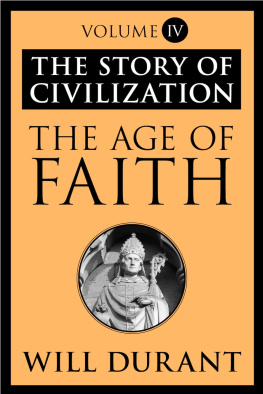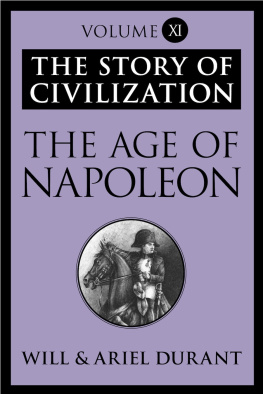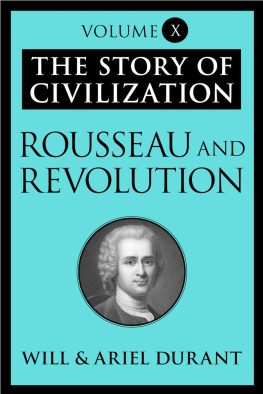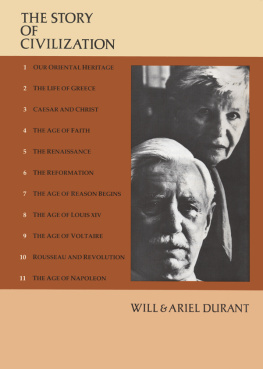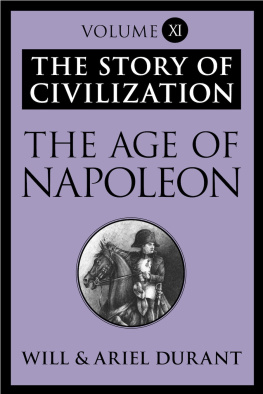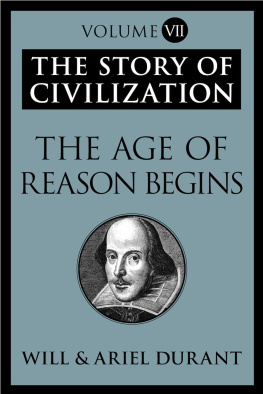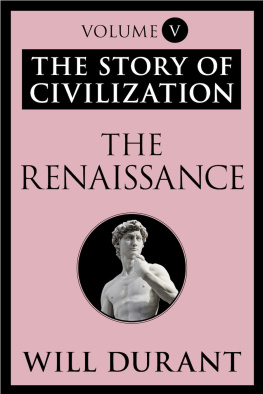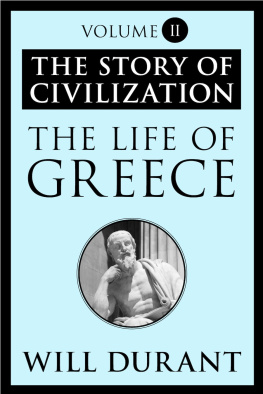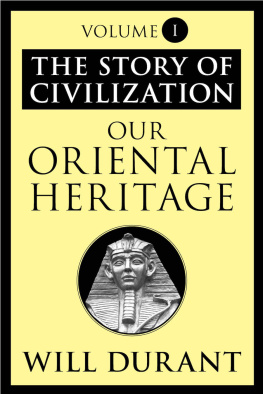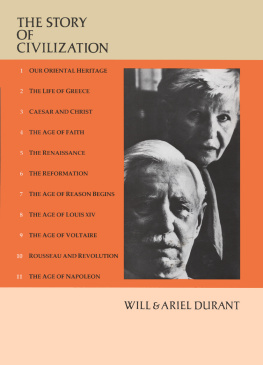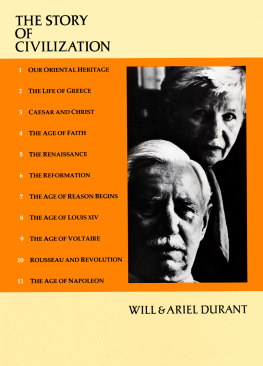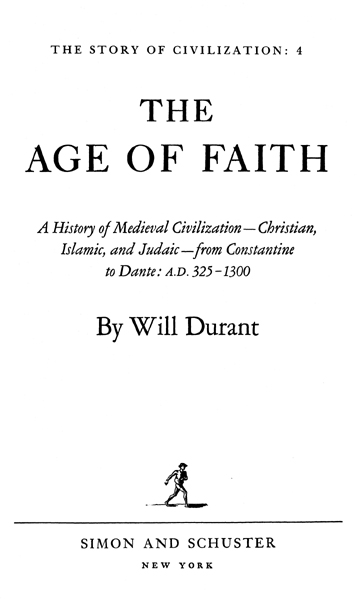
TO ETHEL, GORDON, AND JIM
To the Reader
T HIS book aims to give as full and fair an account of medieval civilization from A.D . 325 to 1300, as space and prejudice will permit. Its method is integral historythe presentation of all phases of a culture or an age in one total picture and narrative. The obligation to cover the economic, political, legal, military, moral, social, religious, educational, scientific, medical, philosophic, literary, and artistic aspects of four distinct civilizationsByzantine, Islamic, Judaic, and West Europeanhas made unification and brevity difficult. The meeting and conflict of the four cultures in the Crusades provides a measure of unity; and the tired reader, appalled by the length of the book, may find some consolation in learning that the original manuscript was half again longer than the present text. Nothing has been retained except what seemed necessary to the proper understanding of the period, or to the life and color of the tale. Nevertheless certain recondite passages, indicated by reduced type, may be omitted by the general reader without mortal injury.
These two volumes constitute Part IV of a history of civilization. Part I, Our Oriental Heritage (1935), reviewed the history of Egypt and the Near East to their conquest by Alexander about 330 B.C ., and of India, China, and Japan to the present century. Part II, The Life of Greece (1939), recorded the career and culture of Hellas and the Near East to the Roman Conquest of Greece in 146 B.C . Part III, Caesar and Christ (1944), surveyed the history of Rome and Christianity from their beginnings, and of the Near East from 146 B.C ., to the Council of Nicaea in A.D . 325. This book continues the study of the white mans life to the death of Dante in 1321. Part V, The Renaissance and the Reformation , covering the period from 1321 to 1648, should appear in 1955; and Part VI, The Age of Reason , carrying the story to our own time, should be ready by 1960. This will bring the author so close to senility that he must forgo the privilege of applying the integral method to the two Americas.
Each of these volumes is designed as an independent unit, but readers familiar with Caesar and Christ will find it easier to pick up the threads of the present narrative. Chronology compels us to begin with those facets of the quadripartite medieval civilization which are most remote from our normal interestthe Byzantine and the Islamic. The Christian reader will be surprised by the space given to the Moslem culture, and the Moslem scholar will mourn the brevity with which the brilliant civilization of medieval Islam has here been summarized. A persistent effort has been made to be impartial, to see each faith and culture from its own point of view. But prejudice has survived, if only in the selection of material and the allotment of space. The mind, like the body, is imprisoned in its skin.
The manuscript has been written three times, and each rewriting has discovered errors. Many must still remain; the improvement of the part is sacrificed to the completion of the whole. The correction of errors will be welcomed.
Grateful acknowledgment is due to Dr. Use Lichtenstadter, of the Asia Institute of New York, for reading the pages on Islamic civilization; to Dr. Bernard Mandelbaum, of the Jewish Theological Seminary of America, for reviewing the pages on medieval Jewry; to Professor Lynn Thorndike, of Columbia University, for the use of his translation of a passage from Alexander Neckham; to the Cambridge University Press for permission to quote translations from Edward G. Brownes A Literary History of Persia; to the Public Library of Los Angeles, and specifically to its Hollywood Branch, and to the Library of Congress, for the loan of books; to Miss Rose Mary DeWitte for typing 50,000 notes; to Dr. James L. Whitehead, Dr. C. Edward Hopkin, and Mrs. Will Durant for their learned aid in classifying the material; to Misses Mary and Flora Kaufman for varied assistance; and to Mrs. Edith Digate for her high competence in typing the manuscript.
This book, like all its predecessors, should have been dedicated to my wife, who for thirty-seven years has given me a patient toleration, protection, guidance, and inspiration that not all these volumes could repay. It is at her prompting that these two volumes are dedicated to our daughter, son-in-law, and grandson.
WILL DURANT
November 22, 1949
An occasional hiatus in the numbering of the notes is due to last-minute omissions.
List of Illustrations
All photographs, with the exception of those otherwise marked, were secured through Bettmann Archive.
BOOK I
THE BYZANTINE ZENITH
325565
CHRONOLOGICAL TABLE
Dates of rulers and popes are of their reigns. All dates are A.D.
226: | Ardashir founds Sasanian dynasty |
24172: | Shapur I of Persia |
251356: | St. Anthony of Egypt |
293373: | Athanasius |
30067: | Hilary of Poitiers |
30979: | Shapur II of Persia |
310400: | Ausonius, poet |
31181: | Ulfilas, apostle to the Goths |
325: | Council of Nicaea |
325403: | Oribasius, physician |
32591: | Ammianus Marcellinus, histn |
32979: | St. Basil |
32089: | Gregory Nazianzen |
331: | B. of Julian the Apostate |
337: | Death of Constantine |
34098: | St. Ambrose |
340420: | St. Jerome |
345407: | St. John Chrysostom |
345410: | Symmachus, senator |
348410: | Prudentius, poet |
35361: | Constantius sole emperor |
354430: | St. Augustine |
359408: | Stilicho, patricius |
3613: | Julian emperor |
3634: | Jovian emperor |
3647: | Valentinian I, Western emp. |
36478: | Valens Eastern emperor |
365408: | Claudian, poet |
36684: | Pope Damasus I |
372: | Huns cross the Volga |
37583: | Gratian Western emperor |
378: | Battle of Hadrianople |
379: | Theon of Alexandria, mathn |
37995: | Theodosius I, emperor |
38292: | Affair of Altar of Victory |
38392: | Valentinian II, Western emp. |
386404: | Jeromes transl, of Bible |
387: | Baptism of Augustine |
389461: | St. Patrick |
390: |

